KNIGHTS OF THE SKIES
April 1915, a German 2 seater plane fell in flames before the guns of French Ace Roland Garros’s monoplane. This was the beginning of a new technique in aerial warfare. It was achieved by firing a machine gun between the blades of a spinning propellor. Although crude it was successful mainly due to small steel plates attached to the propellor blades. The bullets which did not pass between the blades were deflected by the plates without harming the propellor. A new degree of accuracy was made possible by aiming the entire airplane at the target.
The Morane-Saulnier N was one of the few operational monoplanes of WW1. It had an extremely sensitive elevator response and fast landing speed but was considerably more manouverable than its German opponents at the time. The Aileron control was achieved by wing warping.
In addition to the french, 2 British squadrons flew Morane-Saulnier N’s where it was nicknamed the “Bullet” due to th large spinner fitted on the nose.
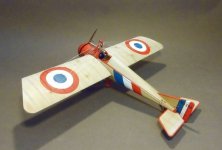
ACE-18
KNIGHTS OF THE SKIES,
MORANE-SAULNIER Type N,
ESCADRILE MS.12, MS 394,1915
(1pc)
Model height 3 1/2” x length 8” x width 11”
A large metal "casserolle" spinner designed to streamline the aircraft caused the engines to overheat because the spinner deflected air away from the engine. In 1915, the spinner was removed from the design and no more overheating problems were found. The removal of the spinner caused very little loss in performance.
The Type N was not particularly successful. Only 49 aircraft were built and it was quickly rendered obsolete by the pace of aircraft development.
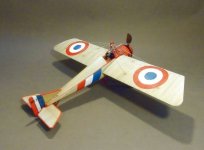
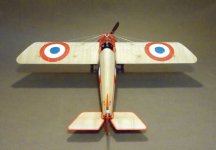
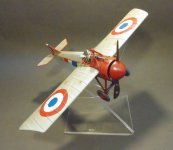
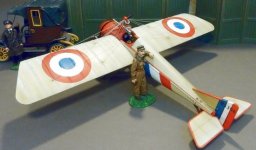
**PLEASE CONTACT YOUR LOCAL DEALER FOR FURTHER INFORMATION**
April 1915, a German 2 seater plane fell in flames before the guns of French Ace Roland Garros’s monoplane. This was the beginning of a new technique in aerial warfare. It was achieved by firing a machine gun between the blades of a spinning propellor. Although crude it was successful mainly due to small steel plates attached to the propellor blades. The bullets which did not pass between the blades were deflected by the plates without harming the propellor. A new degree of accuracy was made possible by aiming the entire airplane at the target.
The Morane-Saulnier N was one of the few operational monoplanes of WW1. It had an extremely sensitive elevator response and fast landing speed but was considerably more manouverable than its German opponents at the time. The Aileron control was achieved by wing warping.
In addition to the french, 2 British squadrons flew Morane-Saulnier N’s where it was nicknamed the “Bullet” due to th large spinner fitted on the nose.

ACE-18
KNIGHTS OF THE SKIES,
MORANE-SAULNIER Type N,
ESCADRILE MS.12, MS 394,1915
(1pc)
Model height 3 1/2” x length 8” x width 11”
A large metal "casserolle" spinner designed to streamline the aircraft caused the engines to overheat because the spinner deflected air away from the engine. In 1915, the spinner was removed from the design and no more overheating problems were found. The removal of the spinner caused very little loss in performance.
The Type N was not particularly successful. Only 49 aircraft were built and it was quickly rendered obsolete by the pace of aircraft development.




**PLEASE CONTACT YOUR LOCAL DEALER FOR FURTHER INFORMATION**

